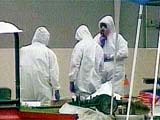Rosanna Xia interviewed Elena Conis, a historian of science and medicine at UC Berkeley and author of "How to Sell a Poison:The Rise, Fall and Toxic Return of DDT."
Xia describes the history as "a gripping examination of corporate influence over science--and how this tried-and-true playbook continues to manipulate public opinion today."
The backdrop of the historian's conclusion is her first book, Vaccine Nation: America's changing Relationship With Immunization. When a debate among public health officials arose about the ethics of denying a chemical to poor nations afflicted with malaria and typhus the corporate think tanks saw their chance.
Conis lays it out:"So these conservative think tanks approached the tobacco industry and said,'We propose publcizing this idea because we think it's a way to do a couple of things: one, popularize the idea that Western nations shouldn't be trusted to set global health agendas; two, that environ- mentalists don't necessarily have humanitarian ideals in mind. And three, I'll pit environmentalists and public health folks against each other--and will therefore be a way to divide liberals amongst themselves."
Death and destruction by disinformation.
Eight months after the first death from anthrax inhalation was reported in Florida, someone finally stood up to liars in public places.
On June 7, 2002, Judicial Watch , "the public interest group that investigates and prosecutes government corruption and abuse," issued a press release headed "Judicial Watch Wants to Know Why White House Went on Cipro Beginning September 11th: What Was Known and When?"
 "Judicial Watch represents hundreds of postal workers from the Brentwood Postal Facility in Washington, DC. Until the Brentwood facility was finally condemned by the CDC, Brentwood postal workers handled all of the mail for Washington, DC, including the 'official mail' that contained the anthrax-laden envelopes addressed to Senators Daschle and Leahy. While Capitol Hill workers received prompt medical care, Brentwood postal workers were ordered by USPS officials to continue working in the contaminated facility. Two Brentwood workers died from inhalation anthrax, and dozens more are suffering from a variety of ailments related to the anthrax attacks. A variety of legal actions are being planned for the disparate treatment and reckless endangerment the Brentwood postal workers faced."
"Judicial Watch represents hundreds of postal workers from the Brentwood Postal Facility in Washington, DC. Until the Brentwood facility was finally condemned by the CDC, Brentwood postal workers handled all of the mail for Washington, DC, including the 'official mail' that contained the anthrax-laden envelopes addressed to Senators Daschle and Leahy. While Capitol Hill workers received prompt medical care, Brentwood postal workers were ordered by USPS officials to continue working in the contaminated facility. Two Brentwood workers died from inhalation anthrax, and dozens more are suffering from a variety of ailments related to the anthrax attacks. A variety of legal actions are being planned for the disparate treatment and reckless endangerment the Brentwood postal workers faced."
 "'The American people deserve a full accounting from the Bush administration, the FBI and other agencies concerning the anthrax attacks. The FBI's investigation seems to have dead-ended, and frankly, that is not very reassuring given their performance with the September 11th hijackers,' stated Judicial Watch Chairman and General Counsel Larry Klayman. 'One doesn't simply start taking a powerful antibiotic for no good reason. The American people are entitled to know what the White House staffers knew nine months ago,' he added."
"'The American people deserve a full accounting from the Bush administration, the FBI and other agencies concerning the anthrax attacks. The FBI's investigation seems to have dead-ended, and frankly, that is not very reassuring given their performance with the September 11th hijackers,' stated Judicial Watch Chairman and General Counsel Larry Klayman. 'One doesn't simply start taking a powerful antibiotic for no good reason. The American people are entitled to know what the White House staffers knew nine months ago,' he added."
Judicial Watch asks, "What Was Known and When?"
Good question. So why did the White House go on Cipro on the very day of the World Trade Center attacks? Larry Klayman said, "We believe that the White House knew or had reason to know that an anthrax attack was imminent or underway."
 The American people heard about the first terrorist anthrax attack on October 4, 2001, not quite a month after the World Trade Center attack. On October 4, 2001, Bob Stevens, a photo editor for American Media's tabloid Sun, lay critically ill in a Florida hospital. The doctors diagnosed inhalation anthrax, a rare disease that workers sometimes contract after exposure to infected livestock or animal hides. Even when contracted in factories that process animal hides, inhalation anthrax is a very rare disease. This was the first case reported since 1976. A Bush spin team went into action immediately.
The American people heard about the first terrorist anthrax attack on October 4, 2001, not quite a month after the World Trade Center attack. On October 4, 2001, Bob Stevens, a photo editor for American Media's tabloid Sun, lay critically ill in a Florida hospital. The doctors diagnosed inhalation anthrax, a rare disease that workers sometimes contract after exposure to infected livestock or animal hides. Even when contracted in factories that process animal hides, inhalation anthrax is a very rare disease. This was the first case reported since 1976. A Bush spin team went into action immediately.
 Stevens's doctor pontificated that it was a case of "a rare and obviously very serious illness that has found its way into the life of one individual." ("One individual" was a sneaky way of saying terrorism was not a factor.) A spokesman for the Centers for Disease Control and Prevention stepped up to the microphones next. "There is absolutely no indication this is tied in any way to terrorism."
Stevens's doctor pontificated that it was a case of "a rare and obviously very serious illness that has found its way into the life of one individual." ("One individual" was a sneaky way of saying terrorism was not a factor.) A spokesman for the Centers for Disease Control and Prevention stepped up to the microphones next. "There is absolutely no indication this is tied in any way to terrorism."
Health and Human Services Secretary Tommy Thompson's message was meant to reassure any remaining skeptics. "We will be responding very aggressively. But I want to point out, once again, that this is an isolated case and it's not contagious."
Florida Lt. Gov. Frank Brogan came forward with an alternative theory to terrorism. He said outdoorsman Stevens fell ill after returning from a trip to North Carolina.
Tommy Thompson helpfully expanded on the "nature red in tooth and claw" angle. "We do know that he drank water out of a stream when he was traveling to North Carolina last week," said Thompson. "But as far as wool or other things, it's entirely possible. We haven't got all of the investigations done and we're doing a tremendous extensive job of investigating everything." He said investigators from the FBI and CDC were tracing Stevens's steps in North Carolina.
 Only one expert contradicted the official line--the Florida state epidemiologist who noted that inhalation anthrax incubates in from six to forty-five days, a period which excluded the trip to North Carolina. The epidemiologist, having demolished the official explanation, was never heard from again.
Only one expert contradicted the official line--the Florida state epidemiologist who noted that inhalation anthrax incubates in from six to forty-five days, a period which excluded the trip to North Carolina. The epidemiologist, having demolished the official explanation, was never heard from again.
The spinners went to work again a day later, October 5, when Bob Stevens died of anthrax inhalation.
Secretary Tommy Thompson reminded the nation that Stevens had probably picked up the infection in the great outdoors. He announced categorically, "There is no terrorism."
The following months of anthrax horrors, of panic, illness, and death, proved the spinners to be dead wrong, but they never apologized.
A few days later, another American Media employee tested positive for anthrax inhalation and received antibiotics. Spotty news reports suggested that the FBI had discovered traces of the virulent Ames anthrax strain in American Media's Boca Raton offices but considered the amounts insignificant.
 Officials at Iowa State University, which is located in Ames, Iowa, said the FBI and the CDC ordered them in early October to destroy the university's collection of over one hundred anthrax samples. The CDC denied the assertion, but the FBI explained that the Ames strain was so widespread as to render Iowa State's samples worthless as forensic evidence. The university followed through on October 10 and 11. Months later, after Northern Arizona State University completed a genetic analysis of a spore sample from the Daschle letter, the Ames strain from Iowa was ruled out after all.
Officials at Iowa State University, which is located in Ames, Iowa, said the FBI and the CDC ordered them in early October to destroy the university's collection of over one hundred anthrax samples. The CDC denied the assertion, but the FBI explained that the Ames strain was so widespread as to render Iowa State's samples worthless as forensic evidence. The university followed through on October 10 and 11. Months later, after Northern Arizona State University completed a genetic analysis of a spore sample from the Daschle letter, the Ames strain from Iowa was ruled out after all.
Meanwhile, a terrorist had been mailing anthrax spores to news organizations. During October, letters containing powdered anthrax arrived in New York at the headquarters of ABC News, CBS News, and The New York Post. Six employees and one employee's infant all tested positive for skin anthrax and were treated. Two weeks after Iowa State University destroyed its collection, Director of Homeland Security Tom Ridge affirmed that the tainted letters contained the Ames strain of anthrax.

Around 10:15 on October 15, a member of Senate Majority Leader Tom Daschle's staff opened an envelope containing a suspicious substance. The Daschle sample became airborne when the envelope was opened, and within 24 hours thirty people had tested positive. The office was quarantined and all mail from Daschle's office was returned. Tom Ridge was unable to brush the letter aside with an offhand "not terrorist related," so he did the next best thing. He declared that the anthrax spores in Daschle's letter were susceptible to antibiotics and had not been "weaponized," meaning they had received no treatment to prevent the particles from clumping together. This assessment later proved to be untrue, but perhaps nobody was listening to Tommy Ridge anymore.
 Army medical researchers at Fort Detrick examined the letter and relayed their findings to the FBI. Two days later, the FBI sent a Fort Detrick sample to Battelle, a military contractor that does secret work for the Pentagon and other government agencies. A Battelle spokesman said they did not know that the Fort Detrick laboratory, for reasons of safety, had irradiated a portion of the anthrax spores before studying them, so Battelle processed its sample in an autoclave and got a lower value for virulence and dispersal qualities. It did not rate the sample as weapons grade. Since experts like William Patrick and Ken Alibek worked for Battelle, this lame story is highly improbable.
Army medical researchers at Fort Detrick examined the letter and relayed their findings to the FBI. Two days later, the FBI sent a Fort Detrick sample to Battelle, a military contractor that does secret work for the Pentagon and other government agencies. A Battelle spokesman said they did not know that the Fort Detrick laboratory, for reasons of safety, had irradiated a portion of the anthrax spores before studying them, so Battelle processed its sample in an autoclave and got a lower value for virulence and dispersal qualities. It did not rate the sample as weapons grade. Since experts like William Patrick and Ken Alibek worked for Battelle, this lame story is highly improbable.
Once again, between federal agencies, communication broke down. Testifying before a congressional committee on Oct. 31, the commanding officer at the U.S. Army Medical Research and Materiel Command at Fort Detrick said he was immediately aware of the virulence of the anthrax contained in the letter to Daschle. On the other hand, the witness testifying for the Centers for Disease Control asserted that for a week after the Daschle letter surfaced the CDC had believed the anthrax was not "weapons grade" and had advised the Postal Service on that basis.
There may have been some confusion about the meaning of "weapons grade." Bioterrorism experts say that "weapons grade" refers to dispersal properties, not to virulence. According to Richard Spertzel, former head of the United Nations biological inspection team in Iraq, material that is readily airborne is weapons-grade. He believes that only someone with a connection to an existing or a former bioweapons program could produce aerosolized anthrax. Meanwhile, the spin patrol diverted our attention to the usual suspect: a deranged loner with a weird agenda who mixed up a batch of anthrax in a sink at home.
On October 16, twelve senate offices closed and hundreds of staffers got anthrax tests. Within days, the House, the Senate, and the Supreme Court shut down. Officials halted all incoming mail and packages addressed to Capitol Hill and diverted them to an Ohio mail irradiation facility for decontamination. On October 25, a mailroom worker in an offsite State Department facility in Virginia was hospitalized with inhalation anthrax. The facility was shut down and all mailroom employees were medicated.
By the time the CDC traced the Daschle letter back to the Brentwood postal facility in northeast Washington and deduced that the Daschle letter had contaminated mail-sorting equipment there, New Jersey and Washington postal workers were falling ill with anthrax infections. Six postal workers contracted inhalation anthrax; two of them died, and four recovered. Three others recovered from skin anthrax, a less serious form of the disease.
 On October 18, Norma Wallace, the first postal worker in New Jersey to contract inhalation anthrax, was hospitalized. Physicians gave her a 50% chance of survival. Ms. Wallace speculated that she was infected when a Hamilton Township automated mail-sorting machine jammed. She said she went to fix the machine and found powder on the electric eye that scans bar codes on envelopes.
On October 18, Norma Wallace, the first postal worker in New Jersey to contract inhalation anthrax, was hospitalized. Physicians gave her a 50% chance of survival. Ms. Wallace speculated that she was infected when a Hamilton Township automated mail-sorting machine jammed. She said she went to fix the machine and found powder on the electric eye that scans bar codes on envelopes.
On the same day, contamination discovered at the Dirksen mail room (which the Daschle letter had transited) should have sent a strong message to officials: anthrax could escape from an unopened envelope. If anyone had searched the literature, but apparently no one did, Canadian officials had already conducted tests of particle dispersal through envelopes, which proved that such dispersal was possible. On October 21, 2001, postal officials shut down the Brentwood Road Mail Processing Center in northeast Washington after two Brentwood workers died of anthrax inhalation. For the first time, health officials tested the postal workers there for infection. Later, epidemiologist Jim Hayslett explained that the CDC had been assuming postal workers would be vulnerable to skin infection but not lung infection. He said that health officials prescribed antibiotics for thousands of postal workers.
The New Jersey State Epidemiologist announced that all the state's anthrax cases were linked to the Hamilton sorting center. "A lot of people are starting to think cross-contamination is a real possibility," he said.
After Howard University received a batch of mail from the District of Columbia's Brentwood Road mail processing center, investigators discovered a trace of anthrax in the university mailroom. Postal Service officials said Howard University's contamination provided concrete evidence that cross-contamination at the Brentwood center was not restricted to government mail.
On November 9, 2001, Postal Service officials announced that four more facilities in New Jersey tested positive for anthrax. All four of them were linked to a regional facility outside Trenton in Hamilton Township. The Hamilton facility had handled anthrax-laced letters sent to Senator Daschle, Tom Brokaw, and the New York Post. Two more facilities in Pennsylvania harbored anthrax spores, one facility in West Windsor and a second regional processing and distribution center in Bellmawr, and these, too, were linked with the Hamilton facility.
It was clearly time for swift, coordinated action, but things went seriously wrong in Bellmawr. Jake Wagman of the Philadelphia Inquirer reported the strange events that transpired after a mail handler at the Bellmawr facility tested positive for anthrax.
"In the nine days after the Oct. 30 announcement of the suspected skin infection, the Bellmawr mail-processing facility would be shut down, reopened for two and a half days, shut down again the next day, reopened for three days, and then closed and opened for a final time on the order of a federal judge who reversed his own day-old ruling.
"Several government agencies converged on the facility, and the mistakes they made--from cleaning the wrong machine to miscalculating by several million pieces the amount of mail delayed by the scare--have led some to question how the country will respond to future terrorism." The local American Postal Workers Union filed a complaint in U.S. District Court, asserting their right to a safe working environment.
Wagman reported that after a federal judge granted a restraining order sought by a union of government workers, a CDC industrial hygienist testified that he and his group were not allowed in the building while the FBI conducted its tests. "And it was later revealed that the wrong mail sorter had been decontaminated, leaving equipment identified as carrying anthrax in operation for three days. Dozens of employees used it to sort millions of pieces of mail."
While staffers from the Supreme Court and Congress were evacuated from their buildings, postal officials, against union protests, insisted that mail facilities remain open.
The New York Metro Area Postal Union was faring no better. The union wanted an injunction to close the Morgan facility until it was completely decontaminated. Although five sorting machines on the Morgan facility's third floor were contaminated with anthrax, the federal government responded with a legal declaration that the site was safe and should remain open.
On November 21, a 94-year-old woman in Connecticut died of anthrax inhalation. She was the fifth anthrax fatality since the Stevens case in October.
 In a batch of segregated, unopened mail, the FBI discovered an envelope addressed to Senator Leahy that had been removed from congressional offices. The envelope was similar to the one sent to Senator Daschle a month earlier, with the same Trenton, New Jersey postmark and inscribed with the same block letters. Postal Inspector Daniel Mihalko announced that an optical reader misconstrued the handwritten ZIP code on the Leahy letter and misrouted it to the State Department, perhaps accounting for the contamination and infections in a State Department mail facility. In other words, cross-contamination from a sealed envelope.
In a batch of segregated, unopened mail, the FBI discovered an envelope addressed to Senator Leahy that had been removed from congressional offices. The envelope was similar to the one sent to Senator Daschle a month earlier, with the same Trenton, New Jersey postmark and inscribed with the same block letters. Postal Inspector Daniel Mihalko announced that an optical reader misconstrued the handwritten ZIP code on the Leahy letter and misrouted it to the State Department, perhaps accounting for the contamination and infections in a State Department mail facility. In other words, cross-contamination from a sealed envelope.
A month after Robert Stevens died of anthrax inhalation in Florida, a new picture emerged. By this time, the Centers for Disease Control and Prevention reported that 32,000 Americans were on a Cipro regimen.
In July 2000, Germany's Bayer AG had negotiated an unprecedented sole endorsement by the Federal Drug Administration of Cipro for anthrax, despite Cipro's high price and largely untested status (one animal study for anthrax treatment in 1993). At a cost of $700 for a sixty-day supply, Bayer made out like a bandit. Cipro sales rose by 1000%. The Bush administration sweetened the pot by awarding an exclusive Health and Human Services contract to the pharmaceutical giant.
A controversial anthrax vaccine was already being produced by BioPort Corporation. In October of 1998, BioPort won an exclusive $29 million contract with the Department of Defense. Subsequently, the Pentagon increased the contract to $49.8 million and advanced BioPort $1.7 million to cover its outstanding debts. Oddly enough, BioPort's major investor was Saudi entrepreneur Fuad El-Hibri, friend of the bin Laden family and former merger and acquisitions manager for Citigroup. The Carlyle Group has been named as another major shareholder.
BioPort, as well as Battelle (which, as mentioned above, first reported a false negative for its test of the Daschle letter), works closely with American intelligence and defense officials on classified programs. Both firms have connections with the U.S. Army Dugway Proving Ground, which admitted in December that the Army facility in the Utah desert has produced weapons-grade anthrax, although the government had supposedly ended the offensive biological weapons program in 1969.
 Barbara Hatch Rosenberg mentioned BioPort, Battelle, and Dugway in her collection of articles titled "Analysis of the Anthrax Attacks" posted on the Federation of American Scientists website in January and early February of 2002. Despite a sniping barrage by spinners, many of Dr. Rosenberg's observations have withstood closer scrutiny. She maintains that the FBI knows that the anthrax attack was an inside job, and given the small number of persons with hands-on experience with the anthrax program over the last five years, the number of suspects is under fifty.
Barbara Hatch Rosenberg mentioned BioPort, Battelle, and Dugway in her collection of articles titled "Analysis of the Anthrax Attacks" posted on the Federation of American Scientists website in January and early February of 2002. Despite a sniping barrage by spinners, many of Dr. Rosenberg's observations have withstood closer scrutiny. She maintains that the FBI knows that the anthrax attack was an inside job, and given the small number of persons with hands-on experience with the anthrax program over the last five years, the number of suspects is under fifty.
Dr. Rosenberg stated that a genetic analysis conducted at Northern Arizona University excluded three academic institutions and two foreign defense laboratories, placing "the focus on USAMRID [Ft. Detrick], Dugway and Battelle as the source of the Ames strain for the letters."
"The optimal US weaponization process is secret--Bill Patrick, its inventor, holds five secret patents on the process and says it involves a combination of chemicals . There is no evidence that any other country possesses the formula."
"The perpetrator must have realized in advance that the anthrax attack would result in the strengthening of US defense and response capabilities. This is not likely to have been a goal of anti-American terrorists, who would also be unlikely to warn the victims in advance. Perhaps the perpetrator stood to gain in some way from increased funding and recognition for biodefense programs. Financial beneficiaries would include the BioPort Corp., the source of the US anthrax vaccine, and other potential vaccine contractors."
"Even if the perpetrator did not make the anthrax himself, just filling the letters with it was a dangerous operation. The perpetrator therefore must have received the anthrax vaccine recently (it requires a yearly booster shot). The vaccine is in short supply and is not generally accessible, and vaccination records are undoubtedly available. The perpetrator also appears to have special expertise in evading contamination while handling weaponized anthrax."
In an interview reported in Salon, Rosenberg stated. "This guy knows too much, and knows things the U.S. isn't very anxious to publicize. Therefore, they don't want to get too close."
In a lecture at the Woodrow Wilson School of Public and International Affairs at Princeton University, Rosenberg said, "We can draw a likely portrait of the perpetrator as a former Fort Detrick scientist who is now working for a contractor in the Washington, D.C. area. He had reason for travel to Florida, New Jersey and the United Kingdom."
The United Kingdom? That rings a bell. Porton Down was a recipient of the same virulent anthrax strain enclosed with the anthrax letters. What has been happening in Porton Down, a biochemical research facility?
The BBC Online reported on August 24, 2001 that Porton Down scientists at the defense center exposed 20,000 volunteers to nerve gas and other chemical and biological agents. Some volunteers believed they were helping find a cure for the common cold. Many of the volunteers now suffer from illnesses they believe were induced by their exposure to bioweapons. The police had been conducting an investigation since 1999 amid growing speculation that criminal charges would be brought. The police had discovered an unusually high death rate among the volunteers.
Almost sadder than the story itself is the realization that the tests were conducted between 1939 and the 1960s.
We hope that the BBC was feeling angry, ironic, or both when it reported, "Defence minister Dr Lewis Moonie told the BBC, 'At present we are conducting a great deal of work on this subject to try to identify what went on. We are also offering medical help and assistance to anybody who feels they need it. They are welcome to contact our people.'"
But that was England, whose inhabitants are not citizens but subjects. Surely our government wouldn't do something like that to us. Would it?

